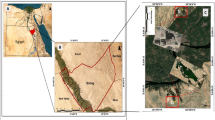Abstract
Allelopathic effects of submerged macrophytes against algae are affected by many environmental factors which can only be measured one by one by traditional methods. Box-Behnken design of response surface methodology was used to optimize three environmental factors (temperature, light intensity and total dissolved solids) of allelopathic effects of Potamogeton pectinatus against Microcystis aeruginosa at the same time. By solving the regression equation and analyzing the response surface contour plots, the optimal conditions of the relatively inhibitory rate of Microcystis aeruginosa were that the temperature was 23°C, the light intensity was 2,700,lx and the total dissolved solids were 4,415,mg/L. Under these conditions, the optimal value of relatively inhibitory rate of Microcystis aeruginosa was 81.9%. According to validation experiments, the results of analysis indicated that the experimental values fitted well with the predicted ones.
Similar content being viewed by others
References
Rice E L. Allelopathy[M]. 2th ed. Academic Press, London, 1984.
Nakai S, Inoue Y, Hosomi M et al. Myriophyllum spicatum released allelopathic polyphenols inhibiting growth of blue-green algae Microcystis aeruginosa [J]. Water Research, 2000, 34(11): 3026–3032.
Donk E V, Wouter J, Bund V. Impact of submerged macrophytes including charophytes on phyto and zooplankton communities: Allelopathy versus other mechanisms [J]. Aquatic Botany, 2002, 72(3/4): 261–274.
Duke I S. Ecophysiological aspects of allelopathy [J]. Planta, 2003, 217(4): 529–539.
Haseeb I, Moss B. Allelopathy of filamentous green algae[J]. Hydrobiologia, 2005, 543(1): 169–179.
Hong Y, Hu H Y. Effects of the aquatic extract of Arundo donax L. (giant reed) on the growth of freshwater algae[J]. Allelopathy, 2007, 20(2): 315–325.
Martin G, Torn K. Classification and description of phytobenthic communities in the waters of the West-Estonian Archipelago Sea [J]. Hydrobiologia, 2004, 514(1–3): 151–162.
Pramanik M H, Nagai M, Asao T et al. Effects of temperature and photoperiod on phytotoxic root exudates of cucumber (Cucumis sativus) in hydroponic culture [J]. Journal of Chemical Ecology, 2000, 26(8): 1953–1967.
Charpentier A, Grillas P, Lescuyer F et al. Spatio-temporal dynamics of a Zostera noltii dominated community over a period of fluctuating salinity in a shallow lagoon, Southern France [J]. Coastal and Shelf Science, 2005, 64(2/3): 307–315.
Cronin G, Lodge D M. Effects of light and nutrient availability on the growth, allocation, carbon/nitrogen balance, phenolic chemistry, and resistance to herbivory of two freshwater macrophytes[J]. Oecologia, 2003, 137(1): 32–41.
Woodcock T, Longcore J, McAuley D et al. The role of pH in structuring communities of Maine wetland macrophytes and chironomid larvae(diptera) [J]. Wetlands, 2005, 25(2): 306–316.
Manohar B, Divakar S. Applications of surface plots and statistical designs to selected lipase catalysed esterification reactions [J]. Process Biochemistry, 2004, 39(7): 847–853.
Abdel-Fattah Y R, Saeed H M, Gohar Y M et al. Improved production of Pseudomonas aeruginosa uricase by optimization of process parameters through statistical experimental designs[J]. Process Biochemistry, 2005, 40(5): 1707–1714.
Wang Y X, Lu Z X. Optimization of processing parameters for the mycelial growth and extracellular polysaccharide production by Boletus spp. ACCC50328 [J]. Process Biochemistry, 2005, 40(3/4): 1043–1051.
Ambati P, Ayyanna C. Optimizing medium constituents and fermentation conditions for citric acid production from palmyra jaggery using response surface method[J]. World Journal of Microbiology and Biotechnology, 2001, 17(4): 331–335.
Abdel-Fattah Y R. Optimization of thermostable lipase production from a thermophilic Geobacillus sp. using Box-Behnken experimental design [J]. Biotechnology Letters, 2002, 24(14): 1217–1222.
Francis F, Sabu A, Nampoothiri K M et al. Use of response surface methodology for optimizing process parameters for the production of β-amylase by Aspergillus oryzae [J]. Biochemical Engineering Journal, 2003, 15(2): 107–115.
Yin X L, You Q H, Jiang Z H. Optimization of enzyme assisted extraction of polysaccharides from Tricholoma matsutake by response surface methodology[J]. Carbohydrate Polymers, 2011, 86(3): 1358–1364.
Aissa I, Sellami M, Kamoun A et al. Optimization of immobilized lipase-catalyzed synthesis of wax esters by response surface methodology [J]. Current Chemical Biology, 2012, 6(1): 77–85.
Author information
Authors and Affiliations
Corresponding author
Additional information
Supported by the National Key Technology Research and Development Program of the Ministry of Science and Technology of China (No. 2012BAC13B05), and Science and Technology Foundation of Beijing Municipal Research Institute of Environmental Protection (No. 2013B05).
Zhang Nan, born in 1977, female, associate research fellow.
Rights and permissions
About this article
Cite this article
Zhang, N., Ji, M., Pan, T. et al. Application of Box-Behnken design in optimization of allelopathic effects of Potamogeton pectinatus against Microcystis aeruginosa . Trans. Tianjin Univ. 20, 344–349 (2014). https://doi.org/10.1007/s12209-014-2205-y
Accepted:
Published:
Issue Date:
DOI: https://doi.org/10.1007/s12209-014-2205-y




